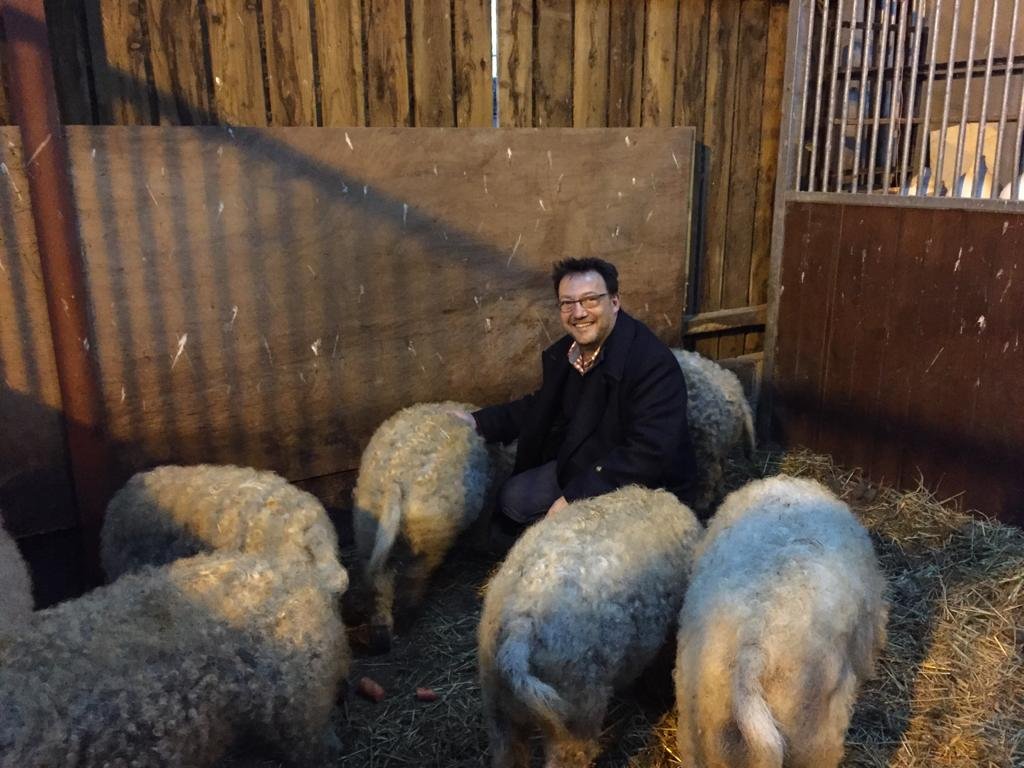Mangalitsa pigs
Late last year, my favourite type of email dropped into my inbox. It was a completely unexpected email from a farmer in Perthshire who had somehow accidentally acquired some pure breed Mangalitsa pigs.
According to this mysterious email, no-one in the farming world was interested in Mangalitsa pigs. As a chef with a reputation for producing what have been called adventurous menus, perhaps I might be interested in taking them?
To be honest, I didn't know what on earth Mangalitsa pigs were but I didn't need to do much research before I knew that yes, I absolutely wanted them for my restaurants. It turns out that Mangalitsa, a slow growing breed which is expensive to farm, have been described as the Wagyu beef of pork. Like Wagyu, their flesh has a lot of marbling running through it.
Regular readers will know that we like to use Wagyu beef from the Highland Wagyu farm in Perthshire. The thought of cooking its porcine equivalent was enough to make my mouth water. Their name in Hungarian means "hog with a lot of lard" and it is this fat which makes the meat succulent and richly flavoured. All of which means that I couldn't wait to get these pigs in the pot and on the menu. The only problem was that these Mangalitsa were some way off being pot-ready. In fact, we needed to find them a good home for a few months. Somewhere that would take good care of them until they were ready to take a starring role on l'escargot menus. At which point, we will introduce Josiah Lockhart, the General Manager of Gorgie City Farm. I am a big fan and supporter of Gorgie City Farm. We work with them throughout the year. Over the years, they have produced numerous pigs for us; several lambs, mutton and even the odd goat every now and then.
Education is part of Gorgie City Farm's remit and that is something we are very happy to support. If we want the nation to have a healthy relationship with food then we need to know what producing it entails. Kids learning where their food comes from seems like a good starting point. Can you see where this is going? I met with Josiah and asked if he would like to look after my Mangalitsa for me. His eyes lit up like a kids' at Christmas and, a week later, nine pigs were heading towards their new home at Gorgie City Farm.
I really recommend that you take your kids to visit the pigs. Entry to Gorgie City Farm is free and, as you can see from the picture, the Mangalitsa are super cute. With an eye-catching woolly appearance, they look more like sheep than the pink-skinned pigs we are used to seeing. I can't help but imagine that they are the sort of thing that might feature in an episode of The Muppets.
This is what Josiah has to say about them: "It is a great product in terms of the meat but it is also ideal for the farm. It is something unusual and the parents and kids love it. The farm always needs more visitors and the Mangalitsa are one way of bringing them in."
If you have never seen Mangalitsa before, it is because very few people have. Interest in them is growing but, at one point, they were so rare, that there were only 150 of them in existence. Originally from Hungary, the breed is derived from the Northern European Wild Boar. It is practically unheard of in the UK.
Farmers aren't keen on them as they take a year to reach the right weight. That is about twice as long to rear as more commercial pigs. This makes them an expensive breed to farm. Working with Josiah, I am perfectly happy to rear my pigs at a natural pace. I reckon that the unique characteristics of the meat, partially a product of their slow growth, will make it worthwhile. Some things are worth waiting for.
It reminds me of the way that the market for Dexter beef has developed in the UK. Ten years ago, when I started cooking with it, no-one was interested. Now, it's popular right across the UK. Already, fellow chefs are asking if I have any Mangalitsa to spare. Obviously, I am thoroughly enjoying saying "Non" to them. Although I am not so daft as to think that I will forever remain the only chef in town with a steady supply of Mangalitsa.
I have yet to try the meat but Josiah had some a few years back. He describes it as dark red in colour with intense marbling. The texture is tender and soft while the flavours is said to be like beef but with a slight sweetness.
Interestingly, part of the feed for our Mangalitsa comes from the Pilot Brewery in Leith. The farm takes the waste from their mash and feeds it to the pigs. It will be fascinating to see what effect that has on the flavour.
Our first Mangalitsa from Gorgie City Farm goes to the abattoir in mid-February. We hope to have Mangalitsa on the menu by the end of February. I'm going to ask Rachel Hammond to use some of it to make charcuterie. I have yet to decide how I am going to cook the different cuts of meat but I am looking forward to working with this new ingredient.
In some ways, the farm is similar to l'escargot restaurants. Like the farm, we get very excited in the kitchen when we have an interesting new product to work with and we know that our customers are very open to trying new things.
Roll on February and the first Mangalitsa on our menus!

